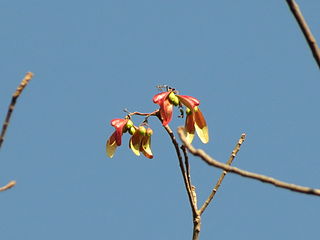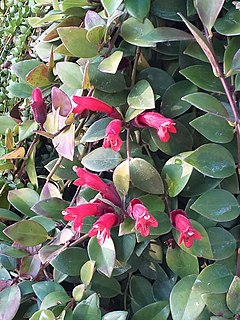Sterculiaceae was a family of flowering plants: based on the genus Sterculia. Genera are now placed in the family Malvaceae, in the subfamilies: Byttnerioideae, Dombeyoideae, Helicteroideae and Sterculioideae.

Firmiana is a genus of flowering plant in the family Malvaceae, formerly placed in the now defunct Sterculiaceae; it may sometimes be called the "parasol tree". The genus name honours Karl Joseph von Firmian.

Heritiera is a genus of flowering plants in the family Malvaceae, subfamily Sterculioideae. They are most dominant tropical forest trees in several areas in eastern Africa and India to the Pacific. Some are mangroves. Several are valuable for their timber and are over-exploited.
Shorea thorelii is a critically endangered tree species, described by Pierre and Lanessan, which is included in the genus Shorea and family Dipterocarpaceae. However, the species name is unresolved according to the Plant List. No subspecies are listed in the Catalogue of Life.

Helicteres is a genus of flowering plants in the family Malvaceae.

Bombax anceps is a tree species now in the Malvaceae that was described by Jean Baptiste Louis Pierre from its range in Indochina. In addition to the nominate subspecies is also B. a. cambodiense.

Pterospermum grewiifolium is a tree species, now placed in the family Malvaceae: in the subfamily Dombeyoideae and described by Pierre. in the genus Pterospermum. No subspecies are listed in the Catalogue of Life and name is unresolved. In Viet Nam the species name is often listed as "P. grewiaefolium" and the vernacular name is lòng mang nhỏ, lòng mang lá cò ke.

Pterocymbium is a genus in the family Malvaceae: in the subfamily Sterculioideae and previously placed in the Sterculiaceae. In Indonesia, P. tinctorium (Kelumbuk) is a significant timber tree.

Colona auriculata is a shrub species first described by Desfontaines, with its current name after Craib; the genus Colona is in the family Malvaceae and now placed in the subfamily Grewioideae. No subspecies are listed in the Catalogue of Life.
Diospyros apiculata is a tropical tree species was described by Hiern and included in the genus Diospyros and family Ebenaceae; no subspecies are listed in the Catalogue of Life. Its Vietnamese name is lọ nồi.
Ryania is a genus of plants in the family Salicaceae; it was previously listed in the now defunct family Flacourtiaceae.
Sterculia hypochroa is a tree species described by Pierre, belonging to the genus Sterculia and the family Malvaceae. No subspecies are listed in the Catalogue of Life. These trees are found in Vietnam, where they are known as trôm quạt.
Sterculia cochinchinensis is a tree species belonging to the genus Sterculia in the family Malvaceae. The name is unresolved according to The Plant List. This species is found in Laos and Vietnam and there are no subspecies listed in the Catalogue of Life.

Sterculia lanceolata is a tree species, belonging to the genus Sterculia and the family Malvaceae. The species can be found in southern China and Vietnam.
Sterculia rubiginosa is a plant species, belonging to the genus Sterculia and the family Malvaceae. The species can be found in the Andaman and Nicobar islands, Myanmar (Burma), southern Thailand, Malesia, the Philippines and Vietnam.
Sterculia stigmarota is a plant, belonging to the genus Sterculia and the family Malvaceae. This species is found only in southern Vietnam and there are no subspecies listed in the Catalogue of Life.

Sterculia lanceifolia is a bush/tree species belonging to the genus Sterculia in the family Malvaceae. This species is found in Bangladesh, NE India, China and Indo-China and there are no subspecies listed in the Catalogue of Life.

Woodfordia is a genus of flowering plant in the family Lythraceae.

Cienfuegosia is a genus of plants, in the family Malvaceae and placed in the tribe Gossypieae. Species can be found in central and south America, Africa including the Arabian peninsula.

Aeschynanthus acuminatus is an Asian species of vine plants in the family Gesneriaceae, with no subspecies listed in the Catalogue of Life. A common name for this and similar species in the genus "lipstick vine".













